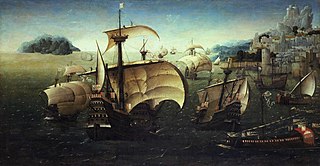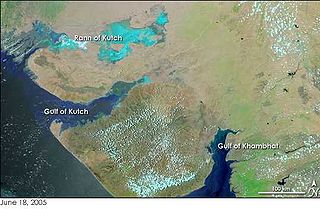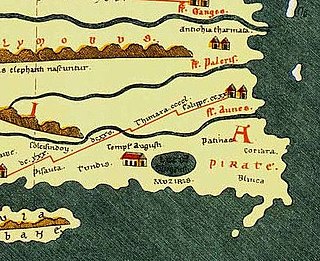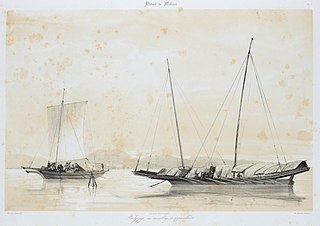
Manchua was a type of sailing vessel used from the eastern coast of Africa to the Malabar Coast, the Indian Ocean, and the East Indies.

Manchua was a type of sailing vessel used from the eastern coast of Africa to the Malabar Coast, the Indian Ocean, and the East Indies.
The manchua was a square-sailed, single-masted, oared vessel, used for cargo transport in the Indian Ocean. [1] It was used both by locals as well as by Portuguese traders. Typically a Malabar vessel, the term was also used for similar large cargo boats of Chinese origin. [2] Traveler Peter Mundy sketched a manchua in his journals and described them as "small vessells of recreation, used by the Portugalls here, as allsoe att Goa, pretty handsome things resembling little Frigatts, Many curiously carved, guilded and painted, with little beake heads." [2]
Also spelled munchua, monchew, munchew, or manchooa, Manchua is called "the Portuguese form" in Hobson-Jobson, which claims that "the original Malayālam word is manji, [manchi, Skt. maṇcha, 'a cot,' so called apparently from its raised platform for cargo]." [1] It may also have originated with "native generic names for sea-going boats from Gujarat to Cochin," including "the machhwu, a fishing and also cargo-boat" and "the mahungiri, a large machhwu used for a trading boat," according to Carnac Temple. [2] He also notes that the Portuguese used manchua "to represent the Cantonese term, man-shun, a sea-going trading vessel" as well as for other simimar vessels from Macau. [2]
First described in 1512, manchuas (and similar vessels described by the same term) were commonly recorded in the region through the 18th century. [1] Clement Downing noted that in the early 18th century, the "town of Bombay was unwalled, and no Grabs or Frigates to protect any thing but the Fishery ; except a small Munchew, which had escaped when Angria took the Company’s Yacht." [3] Carpenter Richard Lazenby was abducted by pirates Seagar, England, Taylor, and Levasseur in 1720 and recorded the capture of one of these vessels in his journals: "They not liking to trust him being a stranger, resolved of seeking water at the Lacker Diva Islands, which they put for directly where they arrived in three days after. The same day of their arrival they took a small Monchew with the Governor of Carwar’s pass on board, who gave them an account that there was no anchor ground among the islands." [4] The remains of two manchuas which sank during an attack on Mombasa in 1696-97 were tentatively identified by archaeological divers after a 2007 investigation. [5]

A ship is a large vessel that travels the world's oceans and other navigable waterways, carrying cargo or passengers, or in support of specialized missions, such as defense, research and fishing. Ships are generally distinguished from boats, based on size, shape, load capacity and purpose. Ships have supported exploration, trade, warfare, migration, colonization, and science. Ship transport is responsible for the largest portion of world commerce.

A sailing ship is a sea-going vessel that uses sails mounted on masts to harness the power of wind and propel the vessel. There is a variety of sail plans that propel sailing ships, employing square-rigged or fore-and-aft sails. Some ships carry square sails on each mast—the brig and full-rigged ship, said to be "ship-rigged" when there are three or more masts. Others carry only fore-and-aft sails on each mast, for instance some schooners. Still others employ a combination of square and fore-and-aft sails, including the barque, barquentine, and brigantine.

A junk is a type of Chinese sailing ship with fully battened sails. Similar junk sails were also adopted by other East Asian countries, most notably Japan, where junks were used as merchant ships to trade goods with China and Southeast Asia. They were found – and in lesser numbers, are still found – throughout Southeast Asia and India, but primarily in China. Historically, a Chinese junk could be one of many types of small coastal or river ships, usually serving as a cargo ship, pleasure boat, or houseboat, but also ranging in size up to large ocean-going vessel. Found more broadly today is a growing number of modern recreational junk-rigged sailboats. There can be significant regional variations in the type of rig or the layout of the vessel; however, they all employ fully battened sails.

The keel is the bottom-most longitudinal structural element on a watercraft. On some sailboats, it may have a hydrodynamic and counterbalancing purpose, as well. The laying of the keel is often the initial step in the construction of a ship. In the British and American shipbuilding traditions, this event marks the beginning date of a ship's construction.

Dhow is the generic name of a number of traditional sailing vessels with one or more masts with settee or sometimes lateen sails, used in the Red Sea and Indian Ocean region. Typically sporting long thin hulls, dhows are trading vessels primarily used to carry heavy items, such as fruit, fresh water, or other heavy merchandise, along the coasts of Eastern Arabia, East Africa, Yemen and coastal South Asia. Larger dhows have crews of approximately thirty and smaller ones typically around twelve.

The spice trade involved historical civilizations in Asia, Northeast Africa and Europe. Spices such as cinnamon, cassia, cardamom, ginger, pepper, nutmeg, star anise, clove, and turmeric were known and used in antiquity and traded in the Eastern World. These spices found their way into the Near East before the beginning of the Christian era, with fantastic tales hiding their true sources.

A carrack is a three- or four-masted ocean-going sailing ship that was developed in the 14th to 15th centuries in Europe, most notably in Portugal and Spain. Evolving from the single-masted cog, the carrack was first used for European trade from the Mediterranean to the Baltic and quickly found use with the newly found wealth of the trade between Europe and Africa and then the trans-Atlantic trade with the Americas. In their most advanced forms, they were used by the Portuguese for trade between Europe and Asia starting in the late 15th century, before being gradually superseded in the late 16th and early 17th centuries by the galleon.

Indian maritime history begins during the 3rd millennium BCE when inhabitants of the Indus Valley initiated maritime trading contact with Mesopotamia. India's long coastline which occurred due to the protrusion of India's Deccan Plteau helped it to make new trade relations with the Europeans, especially the Greeks, and the length of its coastline on the Indian Ocean is partly a reason why it's known as that since 1515, and was known as the Eastern Ocean earlier. The ocean was called so, due to the advent of international trade by the Europeans which still continues to this day. As per Vedic records, Indian traders and merchants traded with the far east and Arabia. During the Maurya Empire, there was a definite "naval department" to supervise the ships and trade. At the end of 1st century BCE Indian products reached the Romans during the rule of Augustus, and the Roman historian Strabo mentions an increase in Roman trade with India following the Roman annexation of Egypt. As trade between India and the Greco-Roman world increased, spices became the main import from India to the Western world, bypassing silk and other commodities. Indians were present in Alexandria while Christian and Jewish settlers from Rome continued to live in India long after the fall of the Roman Empire, which resulted in Rome's loss of the Red Sea ports, previously used to secure trade with India by the Greco-Roman world since the Ptolemaic dynasty. The Indian commercial connection with Southeast Asia proved vital to the merchants of Arabia and Persia during the 7th–8th century. A study published in 2013 found that some 11 percent of Australian Aboriginal DNA is of Indian origin and suggests these immigrants arrived about 4,000 years ago, possibly at the same time dingoes first arrived in Australia.

Ezhimala, a hill reaching a height of 286 metres (938 ft), is located near Payyanur, in Kannur district of Kerala, South India. It is a part of a conspicuous and isolated cluster of hills, forming a promontory, 38 km (24 mi) north of Kannur (Cannanore). The Indian Naval Academy at Ezhimala is Asia's largest, and the world's third-largest, naval academy.

Muchiri, commonly anglicized as Muziris was an ancient harbour and an urban centre on the Malabar Coast. Muziris found mention in the Periplus of the Erythraean Sea, the bardic Tamil poems and a number of classical sources. It was the major ancient port city of Cheras. Core of the city situated in the present day North Paravoor area. The exact location of Muziris has been a matter of dispute among historians and archaeologists. However, excavations since 2004 at Pattanam, near North Paravur and Kodungallur, have led some experts to suggesting the hypothesis that the city was located just there. It was an important trading port for Christian and Muslim merchants arriving from other countries.

Maritime history is the study of human interaction with and activity at sea. It covers a broad thematic element of history that often uses a global approach, although national and regional histories remain predominant. As an academic subject, it often crosses the boundaries of standard disciplines, focusing on understanding humankind's various relationships to the oceans, seas, and major waterways of the globe. Nautical history records and interprets past events involving ships, shipping, navigation, and seafarers.

Sir Richard Carnac Temple, 2nd Baronet, was an Indian-born British administrator and the Chief Commissioner of the Andaman and Nicobar Islands and an anthropological writer.

Boitas were larger boats and ships that were built in the ancient Kalinga region during its maritime history. Kalinga's sea facing regions consisting of coastal Odisha had major trading ports for which boitas were used. Ancient Sadhabas sailed from Kalinga to distant lands such of Sri Lanka and South-East Asia including both mainland and insular Southeast Asian regions for trade.
Maritime history dates back thousands of years. In ancient maritime history, evidence of maritime trade between civilizations dates back at least two millennia. The first prehistoric boats are presumed to have been dugout canoes which were developed independently by various Stone Age populations. In ancient history, various vessels were used for coastal fishing and travel. A mesolithic boatyard has been found from the Isle of Wight in Britain

Maritime history of Somalia refers to the seafaring tradition of the Somali people. It includes various stages of Somali navigational technology, shipbuilding and design, as well as the history of the Somali port cities. It also covers the historical sea routes taken by Somali sailors which sustained the commercial enterprises of the historical Somali kingdoms and empires, in addition to the contemporary maritime culture of Somalia.
Indian Ocean trade has been a key factor in East–West exchanges throughout history. Long-distance trade in dhows and proas made it a dynamic zone of interaction between peoples, cultures, and civilizations stretching from Southeast Asia to East and Southeast Africa, and the East Mediterranean in the West, in prehistoric and early historic periods. Cities and states on the Indian Ocean rim focused on both the sea and the land.

The gallivat was a small, armed boat, with sails and oars, used on the Malabar Coast in the 18th and 19th centuries. The word may derive from Portuguese "galeota" or alternatively, from the Maratha "gal hat" ship. Hobson-Jobson has an extensive discussion of the origins of the term and its usage.

Penjajap, also pangajava and pangayaw, were native galley-like warships used by several Austronesian ethnic groups in maritime Southeast Asia. They were typically very long and narrow, and were very fast. They are mentioned as being used by native fleets in Indonesia, the southern Philippines, Malaysia, and Brunei.

Kelulus or kalulus is a type of rowing boat used in the Nusantara archipelago. It is typically small in size and propelled using oar or paddle. However, for long-distance voyages, this boat can be equipped with sails. It is not the same as prahu kalulis of the eastern part of the Indonesian archipelago.

Ghurab or gurab is a type of merchant and warship from the Nusantara archipelago. The ship was a result of Mediterranean influences in the region, particularly introduced by the Arabs, Persians, and Ottomans. For their war fleet, the Malays prefer to use shallow draught, oared longships similar to the galley, such as lancaran, penjajap, and kelulus. This is very different from the Javanese who prefer long-range, deep-draught round ships such as jong and malangbang. The reason for this difference is that the Malays operated their ships in riverine water, sheltered straits zone, and archipelagic environment, while the Javanese are often active in the open and high sea. After contact with Iberian people, both the Javanese and Malay fleets began to use the ghurab and ghali more frequently.